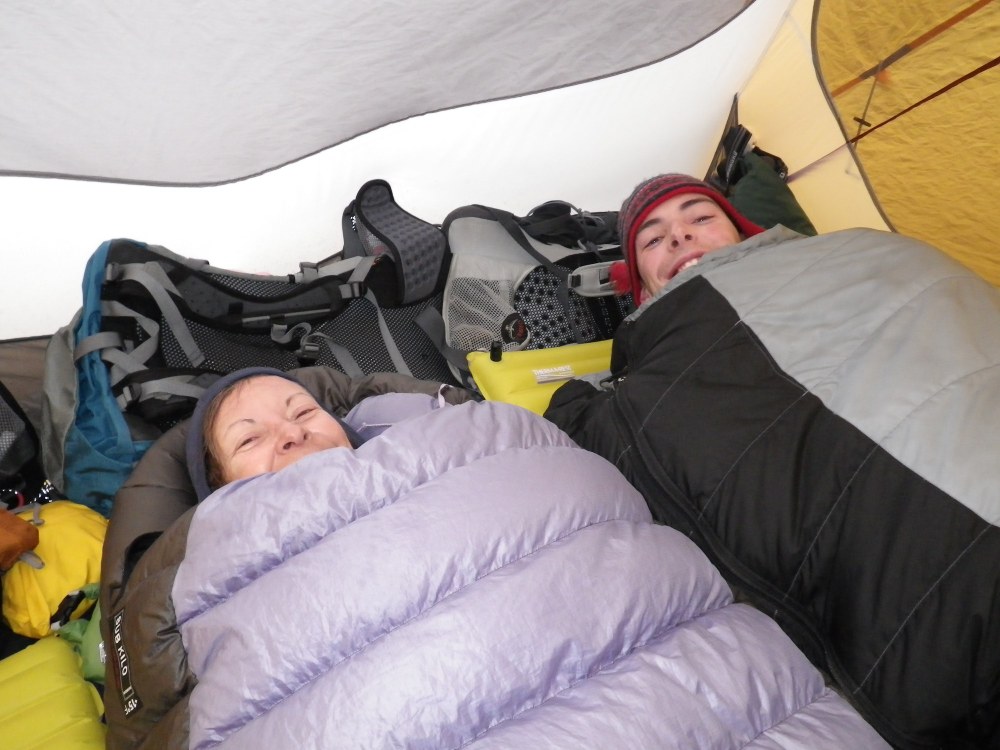
Has it happened to you? I was camping at 11,500 ft at Guitar Lake along the John Muir Trail on the last day of a 2013 backpacking trip with my 3 sons. The low overnight temperature was 32 degrees, and while I should have been comfortable in my 30 degree rated sleeping bag, even with all my clothes on, I was barely warm.
While it may be impossible to always sleep warm, careful section of a sleeping bag can make a warm night more likely.
Seven Considerations
When selecting a sleeping bag, seven interrelated factors need to be considered. They are (mnemonically): 4Ws, 2Cs, and 1D.
Warmth
Sleeping bags are rated. One rating is provided by the manufacturer and another is based on a standardized test - the EN (European Norm) rating.
As my Guitar Lake experience suggests, the manufacturer’s rating may not be an accurate measure of real-world warmth, and differs between manufacturers - one company’s 30 degree bag may be warmer than another company’s 30 degree bag. The EN rating was developed to allow more accurate comparison between bags from different companies.
Not all bags are EN rated. For those that are, two numbers are provided: the Comfort rating, and the Lower-limit rating. The Comfort rating is the lowest temperature at which the bag will keep the average woman or cold sleeper comfortable. The Lower-limit rating is the lowest temperature at which the bag will keep the average man or warm sleeper comfortable (women tend to sleep "colder" than men).
For example, REI sells the Igneo 17 sleeping bag. As the name suggests, REI rates the bag to 17 degrees. The EN Comfort rating is 28 degrees, and the Lower-limit rating is 17 degrees.
Unless you are a warm sleeper, I’d rely on the EN Comfort rating.
Weight
Since you have to carry it, lighter is better. Generally, down is lighter than synthetic insulation for comparable warmth.
Also, a shorter size will be lighter, so get the shortest size that fits you. An additional benefit of a shorter bag is it will be warmer, because there is less space for your body to heat.
The shape of the bag affects weight. Mummy shapes are generally lighter than rectangular shapes, for a given warmth.
Women's Specific
Some bags are specifically designed for women. This may simply mean the bag is shorter or contoured differently than the man’s version, but it might also mean extra insulation in the upper body or foot area, as women tend to get colder in those areas.
Weather Resistance
Especially in our rainy and snowy climate in the PNW, weather resistance is important. Weather resistance is affected by the sleeping bag insulation and its shell.
Wet insulation provides less warmth. This is more pronounced for down than synthetics, though water-resistant downs reduce the difference.
A weather resistant shell helps keep your insulation drier and, therefore warmer. However, a shell that is too impermeable to moisture might retain the moisture your body gives off during the night, wetting your insulation from the inside.
Keeping your bag dry in your pack is also important, so I carry my sleeping bag in a dry bag.
Compressibility
A more compressible bag takes up less space in your pack, and may allow you to carry a smaller and lighter, pack.
Down is usually more compressible than synthetic insulation bags. Down also has varying compressibility, measured by its Fill Power (FP), which is the cubic inches of volume filled by 1 ounce of down. Thus, 800 FP down is more compressible than 700 FP down. A side benefit of greater compressibility is a bag using higher FP down will be lighter, all other things being equal.
While a compression stuff sack can be used to reduce stuffed volume, it adds weight and cost over a non-compression stuff sack.
Cost
All other things being equal, less expensive is better. In reality, reducing cost involves tradeoffs. For example, while synthetic-insulated bags are generally less expensive than down bags, they are likely heavier, less compressible, and less durable.
Durability
Sleeping bags are expensive, so you want them to last. Down generally lasts longer than synthetics, which tend to lose loft (and therefore warmth) with age and repeated stuffing.
Other Considerations
Sleeping Pads
A sleeping bag alone will not keep you warm. Your bag’s insulation underneath you will compress and provide much less warmth, so you need something additional underneath you to provide insulation from the cold ground (or snow) - a sleeping pad.
The insulating value of a sleeping pad is measured by its R value - higher is better. For camping on ground, I’d get a pad with an R value of 2 or greater, though in warm temperatures a lower R value should work. For camping on snow, I’d get an R value of 5 or more.
One option for snow camping is to stack 2 sleeping pads. R values add, so stacking an R value 2 pad over an R value 3 pad is the same as a single R value 5 pad.
Special Considerations for Winter or Snow Camping
EN ratings don’t apply to cold weather bags, so you must base your decision on the manufacturer's rating (and reputation).
For winter camping, you might want to size up your bag, to leave room in the bottom of your bag for boots and other items you want to keep from freezing. Also, for winter camping, a weather resistant shell is more important, because in cold temperatures frost tends to form on the inside of your tent, and then fall onto your sleeping bag - especially when wind is shaking your tent. Weather resistance is particularly important for snow caves; here, you might even want to use a Bivy bag to protect your sleeping bag from snow.
Coming soon!
Future articles will address some related issues, including: sleeping quilts and additional steps you can take to stay warm while camping!
Sleep warm!
 Richard Lambe
Richard Lambe